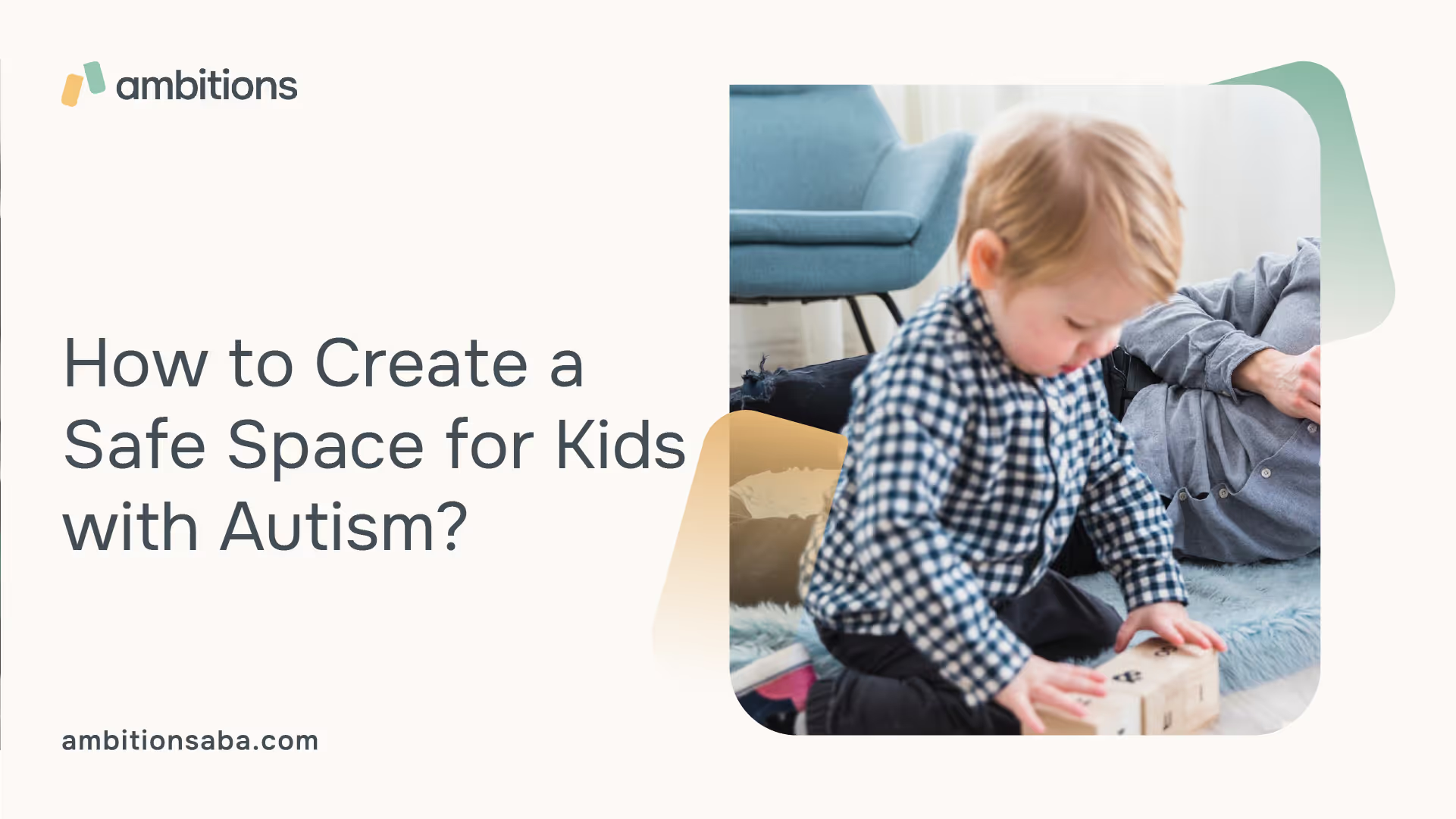Strengthening Families Through Effective Parenting Interventions
Creating an Autism-Friendly Space
Creating a safe and supportive environment for children diagnosed with autism is essential. Parents can implement specific strategies to adapt their living spaces and ensure that their children feel comfortable and secure. This section focuses on adapting the environment and designing sensory-friendly bathroom spaces.

Adapting the Environment
Adjusting the environment can significantly reduce behavioral episodes in individuals with autism. Incorporating elements that minimize frustration and anxiety helps prevent behavioral outbursts before they occur [1]. Here are some key considerations for creating a more autism-friendly environment:
ElementRecommendationsLightingUse natural light or soft, diffused bulbs to prevent harsh glare.ColorChoose calming colors, like soft greens and blues, to create a soothing atmosphere.ClutterKeep spaces organized and clean to reduce distractions and overstimulation.NoiseUse soundproofing techniques or white noise machines to minimize disruptive sounds.Visual SupportsImplement tools like checklists to assist with daily routines. These aids can help children adapt and complete their tasks efficiently.
Sensory-Friendly Bathroom Spaces
Designing a sensory-friendly bathroom can facilitate successful toilet training and create a comforting experience for children with autism. To ensure the bathroom is inviting, consider the following modifications:
Creating a comfortable and sensory-friendly bathroom environment results in a more positive toileting experience. By prioritizing these aspects, parents can significantly enhance their child's overall comfort and confidence in daily routines. For more ideas on supporting children with autism, refer to our resources on how to prepare for an autism diagnosis and autism sensory activities for home.
Enhancing Social Interaction
Fostering social interaction is crucial for children with autism, as it can significantly improve their ability to connect with peers and navigate social situations. This section addresses key strategies for social skills development and tackling social isolation.
Social Skills Development
Developing social skills in children with autism can greatly enhance their ability to interact effectively and positively with others. Tailored strategies can improve their overall social interactions. Techniques for enhancing social understanding include structured social skills groups, social narratives, comic strip conversations, visual supports, modeling, and video modeling. These methods support social skills development at any age [3].
Using tools like Social Stories™ can also provide individualized and specific information about what to expect in different social contexts. These narratives help children to navigate social nuanced scenarios and improve their understanding of social cues, which is essential for successful interactions.
Strategy TypeDescriptionStructured Social Skills GroupsGroup activities designed to enhance social skills through guided interaction.Social NarrativesShort, tailored stories that explain social situations and expectations.Comic Strip ConversationsVisual representation of dialogues to enhance communication.Visual SupportsTools such as charts and schedules that assist in understanding social cues.Modeling & Video ModelingDemonstrating social interactions that children can observe and imitate.
Addressing Social Isolation
Social isolation can be a significant concern for children on the autism spectrum. It is essential to actively engage these children in social settings to mitigate feelings of loneliness. Techniques to address social isolation include fostering inclusive environments where children are encouraged to connect with others.
Strategies can involve structured leisure activities, community events, and support groups that promote interaction in a comfortable atmosphere. Parents can also facilitate playdates or group activities that align with their child's interests. These efforts can create opportunities for meaningful connections, thus alleviating feelings of isolation.
Additionally, involving peers in discussions about autism can help create understanding and acceptance [4]. This process not only informs peers but can also help the child feel included.
By focusing on social skills development and addressing social isolation, parents can effectively support their children in forming fulfilling relationships and increasing their comfort in social settings. For more insights on encouraging independence, visit our article on how to encourage independence in autism?.
Developing Life Skills
Importance of Life Skills
Life skills are essential for individuals with autism to foster independence at home, school, and in the community. Teaching these skills early can enhance self-esteem and contribute to a more fulfilling life in different areas [5]. Life skills encompass a variety of important abilities, including executive function skills such as organizing, planning, prioritizing, and decision-making.
Basic life skills, often referred to as independent living skills, include:
Life SkillDescriptionSelf-CarePersonal hygiene and grooming practicesCookingPreparing simple meals and snacksMoney ManagementUnderstanding budgeting and expensesShoppingMaking choices and purchasing itemsRoom OrganizationKeeping personal spaces tidy and organizedTransportationUsing public transit or navigating independently
Mastering these skills gradually, starting from a young age, can significantly improve the quality of life for children with autism. Additionally, fostering the development of social skills can enhance their ability to engage with others and navigate social situations effectively. This interplay between life skills and social interaction is vital as it can influence overall relationships and opportunities in life.
Teaching Strategies for Independence
Teaching independence to children with autism requires structured approaches and consistent practice. Here are effective strategies to encourage the development of life skills:
By implementing these strategies, parents can effectively support their children's journey toward greater independence. Life skills teaching also fosters a sense of confidence and capability, essential qualities for navigating the world successfully. For additional resources on supporting younger autistic individuals, consider visiting our guide on how to prepare for an autism diagnosis?.
Managing Sensory Sensitivities
Understanding and managing sensory sensitivities is crucial for creating a supportive environment for children with autism. Recognizing how sensory stimuli affect them can lead to better accommodations in daily life.
Understanding Sensory Issues
Individuals with autism often experience unique sensory sensitivities, which can include both hypersensitivity (over-responsiveness) and hyposensitivity (under-responsiveness) to various stimuli. According to Autism Speaks, sensory issues are part of the diagnostic criteria for autism spectrum disorder.
Common Sensory Sensitivities
Sensory InputTypeDescriptionSoundHypersensitivityOverwhelming sensitivity to noises causing distressTexturesHypersensitivityDiscomfort with certain fabrics or materialsLightHypersensitivityDiscomfort from bright lights or flickeringMovementHyposensitivitySeeking constant motion or spinning
Many autistic individuals engage in sensory-seeking behaviors such as stimming, which may include repetitive movements, sounds, or fidgeting. These behaviors help them self-regulate or block out uncomfortable sensory input. However, suppressing stimming can lead to sensory overload or exhaustion, as it hampers their ability to cope with overwhelming stimuli [7].
Creating Sensory-Friendly Environments
A sensory-friendly environment can significantly reduce discomfort for children with autism, allowing them to learn and interact more effectively. Here are some strategies to create such spaces:
Key Strategies for a Sensory-Friendly Environment
StrategyImplementationReduce Noise LevelsUse soft furnishings and noise-canceling headphones to minimize sound distractions.Adjust LightingUtilize soft, natural lighting or dimmable lights to prevent overstimulation from bright lights.Incorporate TexturesProvide a variety of sensory materials (such as weighted blankets or soft, textured toys) tailored to the child’s preferences.Designate Quiet AreasCreate spaces where the child can retreat to if they begin to feel overwhelmed.
Accommodating sensory issues can ease discomfort and provide children with autism more opportunities to socialize, communicate, and participate in their community. Parents can discuss sensory accommodations with their child's IEP team or can consider a 504 plan to facilitate necessary adjustments at school.
For more tips on managing sensory sensitivities, visit our article on how to manage autism sensory issues? and explore sensory activities to further enrich your child's experience within a supportive environment.
Ensuring Safety and Support
Creating a safe and supportive environment for children diagnosed with autism involves recognizing specific safety considerations and implementing individualized support strategies. This ensures that children's unique needs are met, enhancing their comfort and security.
Safety Considerations
Safety is a primary concern for parents of autistic children, especially with challenges such as wandering and elopement. Autistic children may face difficulties that lead to dangerous situations, and understanding the underlying reasons for these behaviors is essential for developing effective prevention strategies.
Safety ChallengeSolutionsWandering and elopementEstablish clear routines and boundaries, secure the environment, and develop a safety plan Autism Learning PartnersCommunication barriersExplore alternative communication methods, such as augmentative and alternative communication (AAC) systems, to help children express discomfort Autism Learning PartnersDifficulty understanding dangerAssess the child's comprehension level and address the barriers to understanding safety; teach safety skills through visual supports Autism Learning PartnersSensory sensitivitiesIdentify sensory triggers and implement sensory-friendly safety measures Autism Learning Partners
These strategies can significantly aid in mitigating potential safety risks and create an environment where children can thrive safely.
Individualized Support Strategies
Individualized support is vital for meeting the specific needs of each autistic child. Tailoring strategies and supports can enhance children’s understanding of their environment and build their skills.
Key strategies include:
For more comprehensive approaches, consider exploring our article on how to encourage independence in autism? and implementing effective aba therapy techniques for nonverbal autism.
By taking these safety considerations and support strategies into account, parents can play a crucial role in creating a safe space that prioritizes the well-being and development of their children with autism.
Inclusive Programs and Resources
Creating a safe and supportive environment for children with autism involves implementing inclusive programs and resources. These initiatives can foster social interaction, develop life skills, and ensure that children feel supported and understood.
Supporting Inclusion Efforts
Inclusive programs are essential for helping autistic children engage with their peers and build connections. Participating in social skills groups can provide children with opportunities to practice their interaction skills in a structured environment. These programs are designed to help them develop meaningful friendships and improve their social understanding.
Table 1 below highlights some effective strategies for promoting inclusion among autistic children:
StrategyDescriptionSocial Skills GroupsFacilitated sessions where children can practice social skills with peers who share similar experiences. (Rainbow Therapy)Visual SupportsTools such as pictures, charts, and graphic organizers that assist with communication and understanding.Structured ActivitiesClear, predictable activities that help children feel secure and engaged while learning social skills.Social NarrativesStories that explain social situations and appropriate responses, tailored to the individual.
These strategies can help mitigate the feelings of frustration, anxiety, and isolation often experienced by autistic individuals as they navigate their social environments [6].
Tailoring Support for Each Child
Every child with autism is unique, having individual needs and challenges. It is crucial to tailor support based on their specific requirements. Parents can collaborate with educators and therapists to create personalized plans that meet the child’s needs effectively. Such plans may involve:
Table 2 provides examples of types of accommodations that can be beneficial for autistic children:
Type of AccommodationExampleSensory BreaksScheduled breaks in a quiet space to manage overstimulation.Modified Class MaterialsUse of visual aids and hands-on materials for learning.Flexible Seating ArrangementsOptions for sitting (standing desks, bean bags) to promote comfort.
By combining tailored support with inclusive resources, parents can empower their children to build connections and navigate their environments more effectively. This approach not only enhances social skills but also fosters independence, encouraging children to thrive in various settings.
For additional resources on encouraging independence, visit how to encourage independence in autism?.
References
[2]:
[3]:
[4]:
[5]:
[6]:
[7]:

